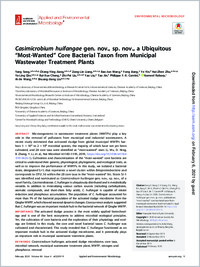Casimicrobium huifangae gen. nov., sp. nov., a Ubiquitous "Most-Wanted" Core Bacterial Taxon from Municipal Wastewater Treatment Plants.
- Song Y Key Laboratory of Environmental Biotechnology at Research Center for Eco-Environmental Sciences, Chinese Academy of Sciences, Beijing, China.
- Jiang CY Key Laboratory of Environmental Biotechnology at Research Center for Eco-Environmental Sciences, Chinese Academy of Sciences, Beijing, China.
- Liang ZL Key Laboratory of Environmental Biotechnology at Research Center for Eco-Environmental Sciences, Chinese Academy of Sciences, Beijing, China.
- Wang BJ Key Laboratory of Environmental Biotechnology at Research Center for Eco-Environmental Sciences, Chinese Academy of Sciences, Beijing, China.
- Jiang Y Beijing Drainage Group Co., Ltd., Beijing, China.
- Yin Y BGI-Qingdao, Qingdao, China.
- Zhu HZ Key Laboratory of Environmental Biotechnology at Research Center for Eco-Environmental Sciences, Chinese Academy of Sciences, Beijing, China.
- Qin YL Key Laboratory of Environmental Biotechnology at Research Center for Eco-Environmental Sciences, Chinese Academy of Sciences, Beijing, China.
- Cheng RX Key Laboratory of Environmental Biotechnology at Research Center for Eco-Environmental Sciences, Chinese Academy of Sciences, Beijing, China.
- Liu ZP Key Laboratory of Environmental Biotechnology at Research Center for Eco-Environmental Sciences, Chinese Academy of Sciences, Beijing, China.
- Liu Y Beijing Drainage Group Co., Ltd., Beijing, China.
- Jin T BGI-Qingdao, Qingdao, China.
- Corvini PF University of Applied Sciences and Arts Northwestern Switzerland, Muttenz, Switzerland.
- Rabaey K Center for Microbial Ecology and Technology (CMET), Ghent University, Ghent, Belgium.
- Wang AJ Key Laboratory of Environmental Biotechnology at Research Center for Eco-Environmental Sciences, Chinese Academy of Sciences, Beijing, China ajwang@rcees.ac.cn liusj@im.ac.cn.
- Liu SJ Key Laboratory of Environmental Biotechnology at Research Center for Eco-Environmental Sciences, Chinese Academy of Sciences, Beijing, China ajwang@rcees.ac.cn liusj@im.ac.cn.
- 2019-12-08
Published in:
- Applied and environmental microbiology. - 2020
Casimicrobium huifangae
WWTP
activated sludge microbiome
core taxa
microbial network
municipal wastewater treatment plant
nitrogen and phosphorus removal
Betaproteobacteria
Microbiota
Phylogeny
RNA, Bacterial
RNA, Ribosomal, 16S
Sewage
English
Microorganisms in wastewater treatment plants (WWTPs) play a key role in the removal of pollutants from municipal and industrial wastewaters. A recent study estimated that activated sludge from global municipal WWTPs harbors 1 × 109 to 2 × 109 microbial species, the majority of which have not yet been cultivated, and 28 core taxa were identified as "most-wanted" ones (L. Wu, D. Ning, B. Zhang, Y. Li, et al., Nat Microbiol 4:1183-1195, 2019, https://doi.org/10.1038/s41564-019-0426-5). Cultivation and characterization of the "most-wanted" core bacteria are critical to understand their genetic, physiological, phylogenetic, and ecological traits, as well as to improve the performance of WWTPs. In this study, we isolated a bacterial strain, designated SJ-1, that represents a novel cluster within Betaproteobacteria and corresponds to OTU_16 within the 28 core taxa in the "most-wanted" list. Strain SJ-1 was identified and nominated as Casimicrobium huifangae gen. nov., sp. nov., of a novel family, Casimicrobiaceae. C. huifangae is ubiquitously distributed and is metabolically versatile. In addition to mineralizing various carbon sources (including carbohydrates, aromatic compounds, and short-chain fatty acids), C. huifangae is capable of nitrate reduction and phosphorus accumulation. The population of C. huifangae accounted for more than 1% of the bacterial population of the activated sludge microbiome from the Qinghe WWTP, which showed seasonal dynamic changes. Cooccurrence analysis suggested that C. huifangae was an important module hub in the bacterial network of Qinghe WWTP.IMPORTANCE The activated sludge process is the most widely applied biotechnology and is one of the best ecosystems to address microbial ecological principles. Yet, the cultivation of core bacteria and the exploration of their physiology and ecology are limited. In this study, the core and novel bacterial taxon C. huifangae was cultivated and characterized. This study revealed that C. huifangae functioned as an important module hub in the activated sludge microbiome, and it potentially plays an important role in municipal wastewater treatment plants.
- Language
-
- English
- Open access status
- bronze
- Identifiers
-
- DOI 10.1128/AEM.02209-19
- PMID 31811031
- Persistent URL
- https://folia.unifr.ch/global/documents/112529
Statistics
Document views: 36
File downloads:
- fulltext.pdf: 0
